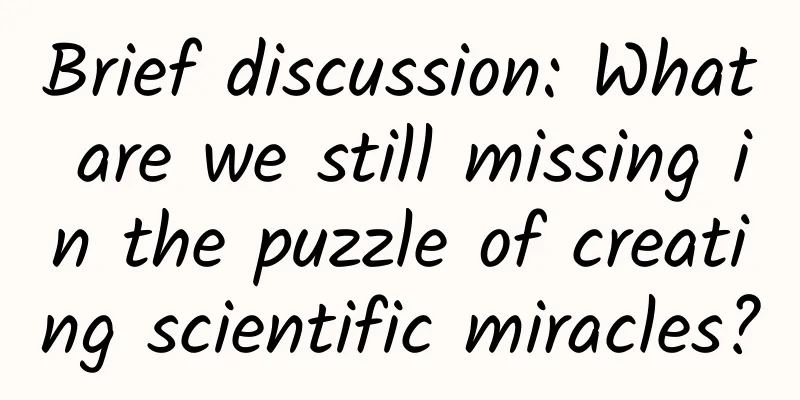The decay width of the W boson has been measured most accurately to date丨Tech Weekly

|
Compiled by Zhou Shuyi and Wang Xiang 15 postgraduate students jointly report their supervisor! Beiyou University: Disqualification of supervisor On the evening of April 9, a 23-page report document was exposed online. Fifteen master's students in the group of Zheng Feng, an associate professor at the School of Communication and Information Engineering of Beijing University of Posts and Telecommunications, jointly reported their supervisor, saying that his supervisor had problems with professional ethics, including insulting, scolding and threatening students, withholding students' labor fees, assigning a large number of non-scientific research chores, asking students to help his daughter cheat on exams, and lack of academic guidance. Many students also showed signs of depression. On April 10, Beijing University of Posts and Telecommunications issued a "Notice on the Handling of Reports on the Improper Professional Ethics of Teacher Zheng". The notice stated that it was verified that Zheng Feng failed to properly perform the duties of a graduate student supervisor and neglected to guide students' academic work; failed to care for and love students, requiring students to engage in matters unrelated to study and scientific research; and failed to provide students with research assistant allowances in accordance with relevant school regulations. The school decided to cancel Zheng Feng's qualification as a graduate student supervisor, stop her teaching work, and give her an administrative penalty of a demotion from associate professor level 7 to lecturer level 10. Party discipline sanctions will be imposed in accordance with procedures in the future. The school will respect the students' wishes and change the supervisors for all students under Zheng Feng's name. Source: Beijing University of Posts and Telecommunications The 2023 Turing Award winners are announced, and the first Turing Award and Abel Prize double winner is born On April 10th local time, the 2023 Turing Award was announced. The Association for Computing Machinery (ACM) awarded the honor to Professor Avi Wigderson of the Institute for Advanced Study (IAS) at Princeton University in the United States, in recognition of his foundational contributions to computational theory, which reshaped people's understanding of the role of randomness in computing, and his decades of leadership in theoretical computer science. The Turing Award is the most prestigious award in the computer field, known as the "Nobel Prize in Computer Science", with a prize of $1 million. Wigderson won one of the highest honors in mathematics, the Abel Prize, in 2021. He is also the first scientist to win both the Turing Award and the Abel Prize. Ivy Vigson | Source: Dan Komoda Ivy Vigson was born in Haifa, Israel in 1956. He studied at the Israel Institute of Technology and Princeton University in the United States, and has been working at IAS since 1999. In a series of groundbreaking studies since the 1990s, Vigson and his collaborators have shown that under some widely accepted computational assumptions, all probabilistic polynomial-time algorithms can be effectively transformed into deterministic algorithms (i.e., derandomized). Vigson has made outstanding contributions in the fields of computational complexity theory, randomness and cryptography, combinatorics, and graph theory, and has also had an important influence in interdisciplinary fields. Vigson is passionate about science communication and has written a popular science book about his research field, which is available for free on his personal homepage (in English): https://www.math.ias.edu/avi/book The spinal cord also has memory, and it can learn new skills in 10 minutes A study published in Science on April 11 showed that memory is not exclusive to the brain, and neural circuits in the spinal cord can achieve memory and motor learning independently of the brain. Researchers have discovered two key groups of spinal cord neurons, one responsible for new adaptive learning and the other for recall after learning is completed. Previous studies have shown that even without a brain, the spinal cord can adjust motor output through practice, but the exact mechanism is still unclear. In the new study, the researchers cut off the brain communication of the mice and applied electrical stimulation to them when the mice's hind limbs drooped to a certain extent. The results showed that in just 10 minutes, the mice learned to raise their hind limbs to avoid electric shocks. The whole process was not intervened by the brain, which shows that the spinal cord can link electrical stimulation with hind limb posture and adjust motor output to avoid the discomfort caused by electric shock. Repeated experiments 24 hours later showed that the memory possessed by the spinal cord can last for a certain period of time and will affect the new learning process. Source: RIKEN Further experiments showed that neurons located in the dorsal spinal cord and expressing Ptf1a are related to spinal cord learning. The inactivation of these neurons will cause mice to no longer adaptively lift their hind limbs in response to electrical stimulation. While neurons located in the ventral spinal cord and expressing En1 are related to memory awakening. The inactivation of these neurons will cause mice to "forget" the leg-lifting behavior after 24 hours. The researchers said the results challenge the common belief that motor learning and memory are limited to brain circuits and are expected to bring new therapies for motor rehabilitation after spinal cord injury. Paper link: Nearly half of new cancer drugs approved by FDA with accelerated approval have no clinical benefit A new study counted 129 anticancer drug-indications (one drug has multiple indications) that received accelerated approval from the FDA from 2013 to 2023. Confirmatory trials showed that among the 46 drugs followed up for more than 5 years, 19 drugs (41%) failed to improve patients' quality of life or prolong their overall survival, only 20 drugs (43%) showed clinical benefits, and another 7 drugs are still being verified. Accelerated approval allows for accelerated drug approval based on alternative or intermediate endpoints to treat certain major diseases and meet unmet medical needs. After obtaining accelerated approval, pharmaceutical companies are required to conduct mandatory confirmatory trials to confirm clinical benefit in order to obtain full approval or withdraw marketing. As of March 1, 2023, the FDA has approved 294 accelerated approvals, of which 180 (61%) were for oncology indications. More than 83% of accelerated approvals from 2012 to 2022 were for oncology indications. The researchers said the results do not argue against the use of accelerated approval for drugs, but rather emphasize that the uncertainty of the benefits of these products should be communicated to patients. They urged drugmakers to collect stronger evidence of clinical benefit during confirmatory trials to support full approval of the drug. Paper link: https://jamanetwork.com/journals/jama/fullarticle/2817337 "Tie Tie" is good for physical and mental health A meta-analysis published in Nature Human Behaviour on April 8 showed that physical contact from humans and other animals can reduce pain, depression and anxiety. The study suggests that touch can improve many physical and mental health outcomes in individuals of all ages (touch must be consensual). The researchers conducted a systematic review and meta-analysis of 212 studies involving a total of 12,966 people. The results showed that touching other people or objects (including robots and even blankets) is good for health. However, compared with touching objects, the psychological benefits of "sticking" with people are greater; newborns benefit more from their parents' touch than from medical staff; different types of touch (such as massage or hugging) do not cause significant differences; more frequent touch will produce more beneficial effects; touching the head (such as the face or scalp) has better health outcomes than other parts of the body (such as the trunk). Paper link: The decay width of the W boson has been measured most accurately to date The European Organization for Nuclear Research (CERN) announced on April 10 that the ATLAS collaboration team at the agency has made the most accurate measurement of the width of the W boson at the Large Hadron Collider (LHC) for the first time. The average value obtained is 2202±47MeV (mega-electron volts), which is basically consistent with the value predicted by the Standard Model, 2088±1MeV. Credit: ATLAS/CERN Many particles are not stable. When the mass of these particles is measured experimentally, the result is not a definite value, but a certain distribution around a certain value. The half-peak width of the distribution is called the particle width. The width Γ and the particle lifetime τ have the following relationship: Γτ=1. The W boson is a fundamental particle that transmits weak interactions. If the W boson decays into a new particle that has not yet been discovered, it will affect the measured width value. If the measured width value is significantly inconsistent with the prediction of the Standard Model, it indicates that new physical phenomena may exist. Previously, researchers have measured the width of the W boson at CERN's Large Electron-Positron Collider and Fermilab's MeV Collider, and found an average value of 2085±42 MeV, which is consistent with the predicted value. In the latest study, the ATLAS collaboration used the proton-proton collision data with an energy of 7 TeV collected during the first run of the LHC to measure the width of the W boson at the LHC for the first time as 2202±47 MeV. This is the most accurate measurement made by a single experiment to date, and although it is wider, the deviation from the predicted value is within 2.5 standard errors. The ATLAS collaboration also measured the mass of the W boson and improved the measurement accuracy. The results show that the latest measured value of the W boson mass is 80367±16MeV, which is consistent with the prediction of the Standard Model. Queqiao-2 relay satellite completes on-orbit communication test The National Space Administration announced on April 12 that the Queqiao-2 relay satellite has completed the in-orbit communication test. After evaluation, the relay satellite platform and payload are working normally, and the functions and performance meet the mission requirements. It can provide relay communication services for the fourth phase of the lunar exploration project and subsequent lunar exploration missions at home and abroad. The mission has been a complete success. On March 20, the Long March 8 carrier rocket satellite support camera captured the image. The Queqiao-2 relay satellite was successfully separated from the carrier rocket, and the solar panels and umbrella antenna were smoothly deployed. The Tiandu test satellite is on the left side of the image. Source: National Space Administration After the Queqiao-2 relay satellite was launched on March 20, it entered the 24-hour large elliptical mission orbit around the moon as planned on April 2 after mid-course correction, near-moon braking, and lunar orbit maneuvers. On April 6, the Queqiao-2 relay satellite successfully completed a communication test with Chang'e 4, which was carrying out a detection mission on the back of the moon. From April 8 to 9, the Queqiao-2 relay satellite conducted a communication test with the Chang'e 6 probe (ground status). The Tiandu-1 and Tiandu-2 communication and navigation technology test satellites launched simultaneously entered the lunar mission orbit on March 29, and successfully separated from the two satellites on April 3. A series of communication and navigation technology verifications are being carried out. Subsequently, the Queqiao-2 relay satellite will provide relay communication services for the Chang'e-4 and the upcoming Chang'e-6 missions as planned, and carry out corresponding scientific exploration when the opportunity arises. Renowned physicist Peter Higgs dies According to the University of Edinburgh, on April 8 local time, Peter Higgs, the 2013 Nobel Prize winner in Physics and British theoretical physicist, passed away peacefully at home due to illness at the age of 94. Peter Higgs | Credit: Claudia Marcelloni/CERN Higgs' most well-known contribution was the proposal of the Higgs mechanism named after him in 1964, which predicted the existence of the Higgs boson and revealed the origin of the mass of all elementary particles, including the W boson. Peter Mathieson, president of the University of Edinburgh, wrote in his obituary: "Peter Higgs was an extraordinary man - a gifted scientist whose vision and imagination enriched our understanding of the world around us. His groundbreaking work has inspired thousands of scientists, and his contributions will continue to inspire generations to come." This article is supported by the Science Popularization China Starry Sky Project Produced by: China Association for Science and Technology Department of Science Popularization Producer: China Science and Technology Press Co., Ltd., Beijing Zhongke Xinghe Culture Media Co., Ltd.
1. Go to the "Featured Column" at the bottom of the menu of the "Fanpu" WeChat public account to read a series of popular science articles on different topics. 2. Fanpu provides a function to search articles by month. Follow the official account and reply with the four-digit year + month, such as "1903", to get the article index for March 2019, and so on. Copyright statement: Personal forwarding is welcome. Any form of media or organization is not allowed to reprint or excerpt without authorization. For reprint authorization, please contact the backstage of the "Fanpu" WeChat public account. |
<<: Will the QR codes we scan every day be used up one day?
>>: Why are you always bitten by mosquitoes? Why are you so delicious in the eyes of mosquitoes?
Recommend
Why should we advertise on CCTV?
Why do we advertise on CCTV? Since the era of sel...
What technological forces are behind the successful return of Shenzhou-14?
At 20:09 on December 4, the return capsule of the...
You can recognize everything by taking a photo. How does AI “understand” pictures?
Welcome to Science Popularization China’s special...
Drinking "ant water" at work? Pay attention to the hygiene of water dispensers!
#All I drink during the 7 days I work is ants'...
National Low Carbon Day丨What are the twelve hours of low carbon life like?
July 10 to 16 this year is the 33rd National Ener...
Free data for life? SAIC-GM upgrades its Internet of Vehicles service
On August 23, SAIC-GM announced that it will laun...
Heytea’s operational skills for its tens of millions in private domain revenue!
According to online information, on January 31 of...
Dot of Science | When did New Year’s Day become New Year’s Day?
END Editor: Guru...
How much is the investment price for Huoqiu Big Turntable Mini Program? Huoqiu Big Turntable Mini Program Merchant Price Inquiry
How much does it cost to invest in the Huoqiu Rou...
After the failure of Google Glass, Google wants to make a hat
According to foreign media reports, a new patent ...
Statistical analysis of mobile game players’ payment behavior in 2014
Recently, a mobile game trading platform released...
The annual drama of China's space station! Two crews will meet in space!
◎ Dai Xiaopei, a reporter from Science and Techno...
How to formulate a promotion plan?
Many times, the process of formulating a promotio...
The latest Douyin film and television account transfer technology in 2021, a film and television work every 3 to 5 minutes, you can make money with just a mobile phone
If you ask what is the hottest and most profitabl...
You have an April Fool's Day marketing strategy package, please check it!
April Fools' Day is here again! Are advertise...









